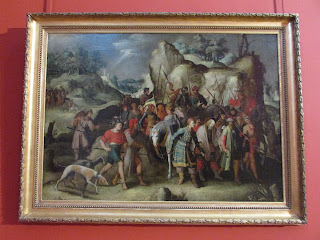Lille's Palais Des Beaux-Arts is considered perhaps France's most important museum outside of Paris, so another visit was an absolute must on my itinerary during this visit. She is usually such a grandly, imposing and attractive building, but on this occasion was having a makeover, and so wasn't looking her best, from the outside at least, her beauty partially hidden behind scaffolding and an advertising hoarding. I was very envious of the children stripped to their cossies enjoying a cooling splash in the Palais' fountains in these searing temperatures. Not prepared to strip off myself, and desperate for respite from the heat, I went inside to the Palais' cooler interior to reacquaint myself with the Beaux-Arts' collections.
I was glad to see these huge, imposing light fixtures designed by artist Gaetano Pesce in 1997 were still in place after all these years, and that the marbled mosaic floors were just as beautiful as I remembered.
I decided to start my viewing upstairs, and headed up the imposing staircases, admiring the high, domed ceiling and stained glass windows en route.
Pieter Breugel the Younger - The Census at Bethlehem, 1610-1620
The works in the first few galleries were technically very well painted, but the majority weren't really my cup of tea. The works displayed here are those that commanded my attention through sheer scale, (many are absolutely huge), the obvious skills displayed in their execution, or as in the case of Vanity, simply because it contained a butterfly reference. I must admit that I am not usually a fan of Rubens' flabby, fleshy paintings, but those on display here were great, as he had reined in the fleshy excesses and concentrated on composition and the dazzling depictions of the fabrics. The results speak for themselves.The lighting wasn't the best in the galleries to preserve the paintings so go to the Palais Des Beaux Arts website to see better pictures of the works without the glare here.
Pieter Breugel the Younger - Saint Paul conduit à Damas après sa conversion, c.Early 17C.
Presumed Bust of a Feudal Lord/Lord of The Manor- Houplin, c. 17th C
Jan van Hemessen - Vanity, c.1535-1540
Peter Paul Rubens - The Martyrdom of Saint Catherine, c.1615
Peter Paul Rubens - The Descent from the Cross, c.1617
Peter Paul Rubens - The Descent from the Cross, (study) c.1617
Anthony van Dyke - Christ on the Cross, c.1630
Peter Paul Rubens - Prometheus Chained, 1611-1612
Pieter van Mol - The Annunciation (detail), second half of the 17th C.
Jean Baptiste de Champaigne - The Good Shepherd, 17th C.
Jean-Baptiste Siméon Chardin - The Silver Goblet, c.1730
During my visit there was a special exhibition taking place which showcased the costume designs for the BBC historical drama series - Versailles, currently on BBC2 and I-Player. The costumes were absolutely exquisite, and the detailing on the buttons and embroidery on the mens designs was amazing as you can see from the close ups below. I was reminded of the wonderful costumes I saw earlier this year at Venice Carnival (here). That the costume designers go to such lengths for something that will probably only get minutes of airplay at most, shows a true dedication to their craft.
Making my way around the first floor I arrived at the modern collection of 19th and 20th century art. This being France, the Impressionists and their radicalism in art during that period were particularly well represented.
Claude Monet - La Débâcle à Vétheuil, avec vue sur Lavacourt, 1880
Auguste Rodin - L'Ange déchu,1895
Edouard Manet - Berthe Morisot With a Fan,
Edouard Vuillard - Fleurs dans un vase, 1904
Edouard Vuillard - Bouquet de roses, 1905
Claude Monet - Vetheuil in the Morning, 1901
Auguste Rodin - La toilette de Vénus, 1890-1906
Edouard Vuillard - Fleurs dans un vase, 1905
Henri de Toulouse Lautrec - Dans L'atelier, La pose du modèle, 1885
Vincent Van Gogh - Les Vaches, 1890
Émile Bernard - Les Cueilleuses de poires, 1888
Francisco Goya - Time and the Old Women, c.1808-1812
Velázquez - Le garrot, c.1808-1812
Francisco Goya - The Young/The Letter, c.1814-1819
The view from the first floor down into the spacious atrium at the Palais.
František Kupka - Traits animés, 1957
Fernand Léger - Le Papillon sur la roue (The Butterfly on the Wheel), 1948
Bernard Buffet - Deux nus debout, 1949
Marc Chagall - L'Apparition de la famille de l'artiste, 1935-1947
Sonia Delauney - Rhythm Colour no. 1076, 1939
Pablo Picasso - Femme Assise, 1945
Fernand Léger - Women with a Blue Vase, 1935
Serge Poliakoff - Composition, 1954
The first floor completed, it was now time to head back downstairs to ground level for a well deserved latte and cake to gather myself, and steel my nerves to visit the lower level of the Palais. The lower level of this building used to be so dark that it creeped the bejesus out of us. You could literally sense other presences down there from the buildings past. Thankfully on this visit even though the light levels are still very subdued to preserve the Medieval artworks on display, the curators have allowed more lighting whilst they are undergoing a makeover, and as a result the atmosphere is not nearly as eerie or menacing as it used to be.
Back up on the ground floor I made my way around to the wonderful sculpture gallery, and was lucky enough to have had it all to myself.
Jean-Antoine-Marie Idrac - L'Amour piqué, 1876
Auguste Rodin - Descent into Hell, 1898
Emmanuel Frémiet - The Knight Errant, 1878
I was so pleased that I got the chance to revisit the Palais Des Beaux-Arts and its collections. Hopefully by the time of my next visit to Lille the scaffolding and advertising hoarding obscurring the facade of this beautiful building will be gone.
Le Palais Des Beaux Arts
Place de la République
59000 Lille,
France




































































